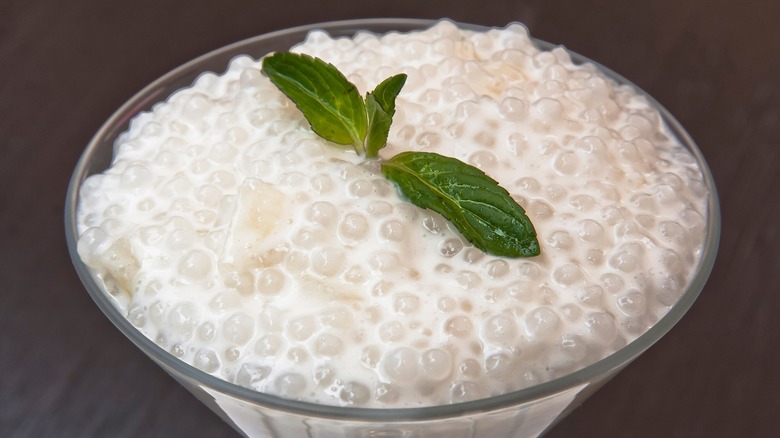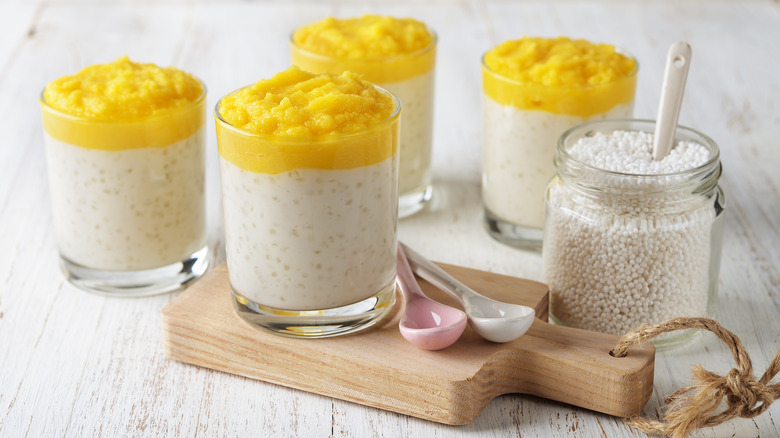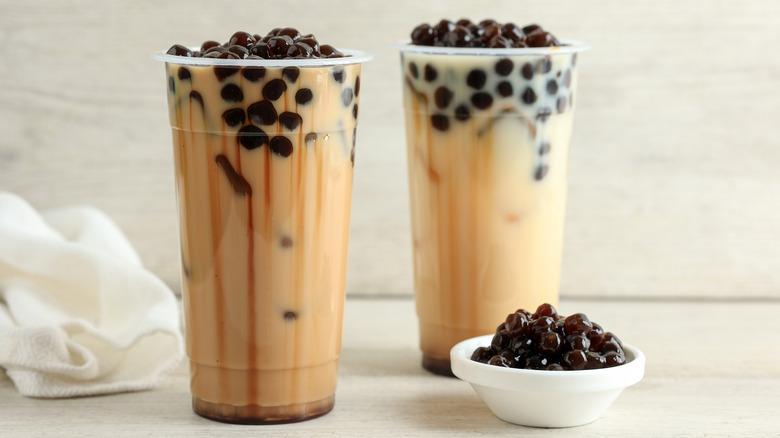What Are The Little Balls In Tapioca Pudding Made Of?
Tapioca pudding is a nostalgic dessert known for its unique texture. Those chewy little balls that fill the creamy custard are what give the treat its name. These gel-like tapioca spheres — or pearls, as they are often called – are made from the cassava plant. Cassava is also known as yuca or manioc, depending on where it's grown. To make tapioca, the starch is extracted from cassava roots, and then it gets processed into products like flour, flakes, and pearls.
Dried tapioca balls start off hard and white, but turn soft and translucent when cooked. The nearly-flavorless pearls soak up the taste of whatever they are cooked with, making them a versatile ingredient for both sweet and savory recipes — like tapioca pudding, of course. Tapioca pudding tastes similar to rice pudding, but the chewy and somewhat gummy quality of tapioca pearls is what sets the two apart. This treat is categorized as a milk pudding, a class of sweetened creams and custards often cooked and thickened with starches such as rice, arrowroot, semolina, and even macaroni.
Tapioca pudding is commonly flavored with sugar and spices, like vanilla and cinnamon, or even raisins. The chewy pearls can also be used in unexpected ways as an ingredient substitute. Their globular and toothsome bite make for an excellent gluten-free stand-in for couscous, and even a convincing vegan mock caviar.
The origins of tapioca pudding
Native to South America, cassava is similar to potatoes, and is also grown throughout Asia and Africa. Tapioca pudding originated in 18th century Brazil as "pudim de tapioca," made with coconut milk. It's often set in a ring mold and is much firmer than what the British and Americans call "tapioca pudding." The modern milk pudding version was reportedly invented in Boston.
Legend has it that in 1883, housewife Susan Stavers put cassava roots brought from overseas through a coffee grinder to make pudding for a sailor. She began selling it, and her recipe was later purchased by the Minute Tapioca Company, which produced a shelf-stable, quick-cooking version. That company was later bought by the Postum Cereal Company, which merged with Kraft Foods in 1989. Kraft Minute Tapioca us sold by the box to this day.
Both cassava and tapioca flours can be used as thickeners in soups, stews, and pie fillings, as well as for density and chew in gluten-free baked goods. Cassava flour is made from the whole plant, while tapioca flour utilizes only the roots. As for tapioca pearls, some people find the chewy and slippery texture delightful, while others are put off by their consistency. Associated with school lunch by older generations in Britain, it has earned derogatory nicknames such as frogspawn or eyeball pudding. The dessert has fallen out of favor in many western cultures, but tapioca pearls remain popular as ever in other nations.
Boba tea and other regional tapioca dishes
Boba tea, aka bubble tea or pearl milk tea, uses the same cassava-based balls as tapioca pudding. Originally from Taiwan, the drink's popularity exploded in the United States in the 2010s, and today boba shops are common in major American cities. Even Starbucks has introduced its own version of boba. The big difference between the tapioca in pudding versus boba is the size and color of the pearls. Boba usually get their darker color from being cooked in brown sugar.
Aside from drinking them, you can also do your oatmeal a huge favor with boba pearls by using them as a sweet topping. And in Brazil, tapioca is used for much more than desserts — the country's delicious, gluten-free cheese bread known as pão de queijo is made with tapioca flour. Thanks to companies like Brazi Bites from Shark Tank, you can buy bags of this cheesy snack in the United States and other countries.
In India, a dish called sabudana khichdi is made for Hindu festivals and fasting rituals (sabudana is Hindi for tapioca pearls). This curry dish is made with tapioca pearls, potatoes, toasted peanuts, and spices. Another festival food, sabudana kheer, is similar to tapioca pudding, but flavored with cardamom and saffron. Sakoo sai moo is yet another tapioca-centric street food, made in Thailand. It's essentially a dumpling with tapioca balls, seasoned pork, peanuts, and pickled radishes, which gets topped with fried garlic and chilis.



